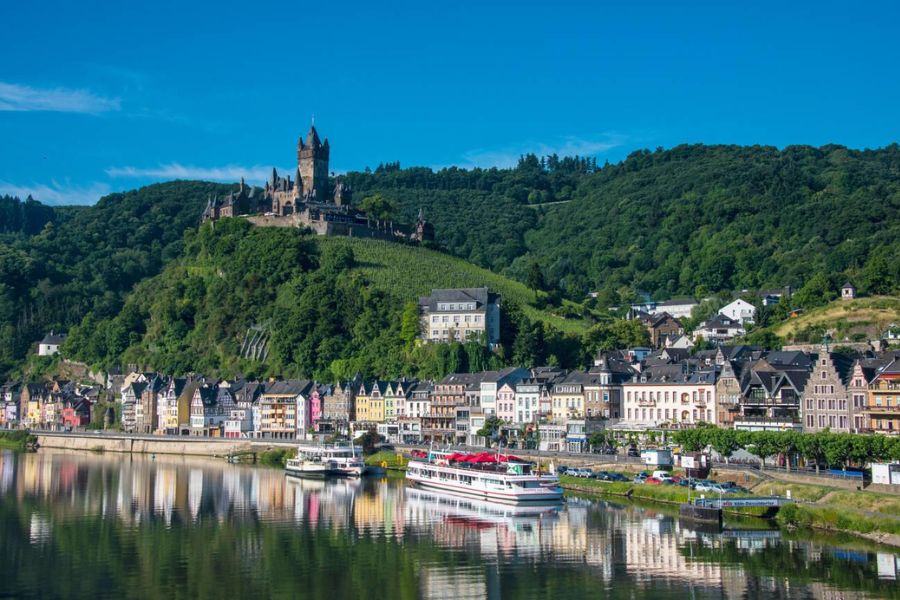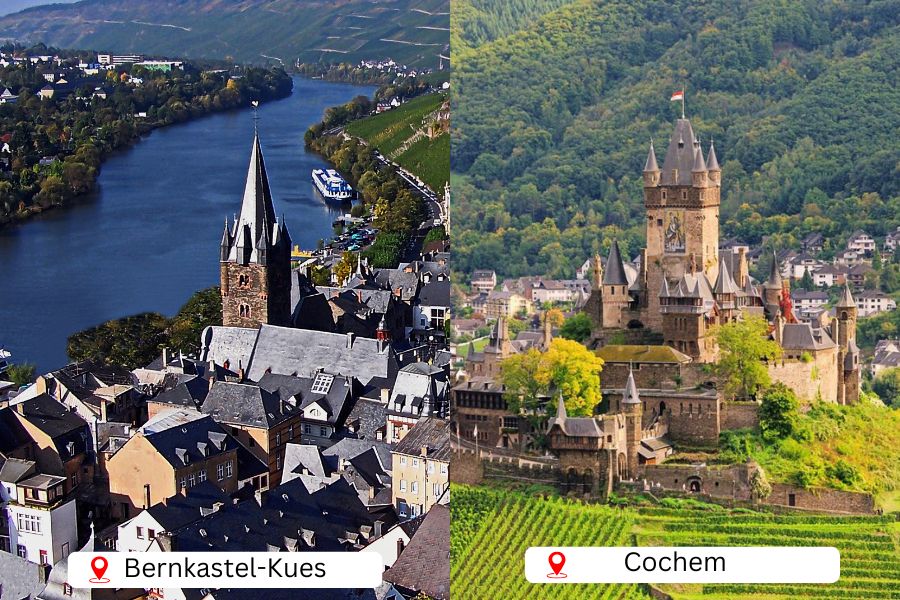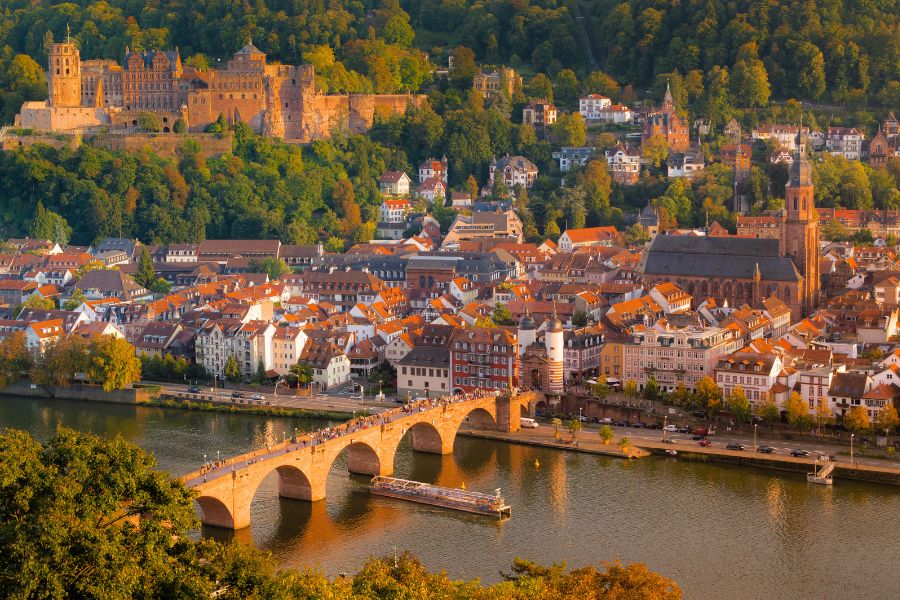Winding along the Moselle River has been one of my most memorable European adventures. The scenic route takes you through a fairy-tale landscape where vineyards cascade down steep hillsides and medieval castles watch over charming villages. This picturesque German wine region offers the perfect blend of history, culture, and world-class Rieslings that simply can’t be experienced anywhere else.
Driving through the Moselle Valley gives you the freedom to discover hidden gems at your own pace. You can find centuries-old wineries tucked in quaint towns like Zell and majestic fortresses like Burg Eltz nestled in the surrounding hills. During my recent road trip, I stopped at family-owned vineyards where generations of winemakers proudly shared their craft and history. The personal connections made while sampling wines overlooking the river valley created memories that packaged tours simply can’t deliver.

What makes this journey truly special is how the Moselle’s winding path shapes the experience. Around each bend, new vistas unfold. I found myself constantly pulling over to capture photos of the ever-changing landscape, especially when the morning mist hung over the river or when sunset painted the vineyards golden.
Mapping the Moselle: A Journey through Villages and Vineyards
The Moselle Valley unfolds like a storybook, with winding river paths connecting charming villages and steep vineyard slopes. During my road trip, I discovered this region offers a perfect blend of natural beauty, cultural heritage, and wine traditions unlike anywhere else in Europe.
The Heart of German Wine Country: Moselle Valley and River
The Moselle (or Mosel) River flows gently through one of Germany’s most picturesque landscapes. This region has been producing wine since Roman times, with vineyards that cling dramatically to steep slopes.
I was amazed by how the river carves its way through valleys, creating a perfect microclimate for Riesling grapes. Some of the steepest vineyards in the world are here, with gradients reaching up to 65 degrees!
Driving along the river in spring 2025, I noticed the distinctive blue slate soil that gives Moselle wines their mineral character. Local winemakers told me this terroir creates the crisp, fruity notes that make these Rieslings world-famous.
The valley’s unique geography shields the vines from harsh weather, allowing for a longer growing season than other German wine regions.
A Tapestry of Landscapes: From Vineyard Slopes to River Bends
The Moselle Valley’s scenery changes dramatically around every bend. Steep vineyard terraces rise from the riverbanks, creating a patchwork of green that’s especially stunning in late summer.
During my drive, I stopped at several panoramic viewpoints where I could see how the river loops back on itself in tight curves. The Moselle makes a total of 26 major bends between Trier and Koblenz!
Medieval castles perch on rocky outcrops above the valley, standing guard as they have for centuries. The contrast between the cultivated vineyards and wild forested hills creates a landscape that’s both orderly and untamed.

In the morning light, mist often hangs over the river, creating ethereal scenes that photographers dream about. I recommend bringing a good camera for these magical moments.
Charming Villages Along the Moselle: Bernkastel-Kues and Cochem
Bernkastel-Kues captured my heart with its medieval market square and half-timbered houses. The colorful buildings date back to the 17th century, giving the village a storybook quality.
I wandered through narrow cobblestone streets and discovered the famous Spitzhäuschen (Pointed House), an unusually narrow building that seems to defy gravity. Don’t miss the ruins of Landshut Castle overlooking the town – the hike up rewards you with amazing valley views.
Further downstream, Cochem offers another perfect stop. The imposing Reichsburg Castle dominates the town from its hilltop perch. After touring the castle’s Gothic and Romanesque rooms, I enjoyed a coffee at a riverside café.

Cochem’s old town feels like stepping back in time, with its town gates, historic church, and weekly market. The village comes alive during wine festivals, where locals share their traditions with visitors.
Uncovering the Wines of Moselle: Varieties, Tastings, and Traditions
The Moselle Valley produces some of the world’s finest white wines, with a winemaking tradition dating back to Roman times. During my travels through this picturesque region spanning Germany, Luxembourg, and France, I discovered a wine culture deeply rooted in tradition yet embracing modern techniques.
The Quintessence of Riesling: Understanding Moselle’s Signature Wine
Riesling reigns supreme in the Moselle Valley, producing wines that are considered among the best in Germany and globally renowned. What makes these Rieslings special is the unique terroir – slate-rich soils and steep vineyards that sometimes reach inclines of 65 degrees (the world’s steepest!).
During my tastings, I noticed the remarkable acidity balanced with fruity notes that characterize Moselle Rieslings. The wines range from bone-dry (trocken) to lusciously sweet (auslese and beyond).
The famous “Zeller Schwarze Katz” (Black Cat of Zell) is a classic example I encountered – a crisp, fruity Riesling with a fascinating legend behind its name. Local winemakers explained how the cool climate creates a slow ripening process that develops complex flavors while maintaining refreshing acidity.
Embarking on a Wine Tasting Journey: Tips and Must-Visit Vineyards
Planning wine tastings in the Moselle requires some strategy. I found staying in towns like Bernkastel, Traben-Trarbach, or Cochem provided excellent bases for exploration.
Top Vineyards Worth Visiting:
- Dr. Loosen Estate (Bernkastel) – Known for exceptional Rieslings
- Markus Molitor (Wehlener Sonnenuhr) – Beautiful tasting room with panoramic views
- Willi Haag (Brauneberg) – Family-run winery with excellent value
- JJ Prüm (Wehlen) – Historic producer of world-class sweet Rieslings
Most vineyards offer tastings for 5-10€, often waived with purchase. I recommend calling ahead as many smaller family operations appreciate appointments.

The Via Mosel route connects the best wineries across all three countries, making it easier to plan your journey. Don’t miss the opportunity to chat with the winemakers – their passion and knowledge enhanced my appreciation tremendously.
Moselle Gastronomy: Pairing Food and Wine in the Valley
The Moselle’s culinary scene perfectly complements its wines. I discovered that local chefs understand how to pair regional dishes with the valley’s distinctive wines.
Traditional dishes that pair beautifully with dry Rieslings include:
- Forelle Blau (poached river trout)
- Gefillte Rinderbrust (stuffed beef breast)
- Zwiebelkuchen (onion tart) – especially delicious in autumn
For sweeter Rieslings, the regional cheese plates featuring soft cheeses like Limburger create perfect harmony. Many wineries now offer their own restaurants or tasting menus.

I especially enjoyed the riverside restaurants in Bernkastel, where watching boats pass by while sipping local wine and sampling regional specialties created unforgettable dining experiences. The seasonal nature of the cuisine means spring and autumn visits offer different but equally delightful flavors.
Castles of the Moselle: Historical Grandeur Meets Modern-Day Exploration
The Moselle Valley’s landscape is punctuated by magnificent castles that tell stories of medieval power struggles and royal ambitions. These stone sentinels stand guard over the winding river, offering visitors a journey through centuries of European history.
Majesty on the Hill: Cochem Castle and Its Panoramic Views
Reichsburg Castle in Cochem was my first castle stop, and it completely took my breath away. Perched dramatically on the highest hill above the town, this medieval fortress offers sweeping views of the Moselle River that are worth the climb alone.
I joined a guided tour that revealed the castle’s fascinating history – destroyed during the Nine Years’ War and beautifully restored in the 19th century. The neo-Gothic architecture blends seamlessly with genuine medieval elements.

Don’t miss the falconry show on the castle grounds! I watched in awe as trained birds of prey soared against the backdrop of vineyard-covered hills. After exploring, I took the chairlift from town for even more spectacular views of the castle and valley below.
Visitor Tip: Arrive early to avoid crowds, especially during summer months.
Timeless Legacy: Venturing Inside Burg Eltz
Unlike many castles in the region, Burg Eltz stands remarkably intact after 850+ years. Hidden in a lush forest valley, this fairytale castle has been owned by the same family for 33 generations.
The 45-minute guided tour took me through rooms filled with original furnishings, armor, and artwork. The Treasury houses gold and silver artifacts that showcase the wealth and influence of medieval nobles.
What I loved most was the castle’s authentic medieval atmosphere. With its multiple towers and half-timbered sections, it feels frozen in time. The surrounding hiking trails offer picturesque approaches to the castle from different angles.
The preserved medieval kitchen was particularly fascinating – I could almost imagine cooks preparing feasts for knights and nobles centuries ago.
Rhine Romance: A Side Trip to Heidelberg and Its Castle
While technically not on the Moselle, Heidelberg Castle is an easy day trip that I’d highly recommend. The massive red sandstone ruins dominate the hillside above this charming university town on the Rhine.
The castle’s Renaissance architecture represents a different era than the medieval Moselle fortresses. I wandered through impressive courtyards and marveled at the enormous Heidelberg Tun – a wine barrel so large it has a dance floor on top!
The castle terrace provides postcard-perfect views of Heidelberg’s Old Town and the Neckar River. I timed my visit for sunset, when the golden light bathes the castle ruins in a magical glow.

The funicular railway makes access easy, though the walking path through gardens offers a more romantic approach if you’re up for a moderate hike.
Planning Your Stay: Accommodations and Logistics
Finding the right place to stay and figuring out transportation can make or break your Moselle Valley adventure. I’ve tested several options during my trips and discovered some gems that offer both comfort and convenience.
Selecting Your Home Base: Hotels in the Moselle Valley
I’ve found that choosing the right town as your base is crucial for exploring this stunning wine region. Bernkastel-Kues has been my favorite home base, with its charming half-timbered buildings and central location. Hotel Café Zur Alten Post offered me cozy rooms with vineyard views at reasonable prices.
Cochem is another excellent choice if you want to be near Burg Eltz. During my stay at Hotel Zehnthof, I could walk to Cochem Castle in just 15 minutes.
Trier makes sense if you’re interested in Roman history, while Traben-Trarbach offers a quieter atmosphere with beautiful Art Nouveau buildings.
Top towns for accommodations:
- Bernkastel-Kues (central location)
- Cochem (near Burg Eltz)
- Trier (Roman history)
- Traben-Trarbach (quieter vibe)

Getting Around: Transport Tips for the Savvy Traveler
Having a rental car gave me the most flexibility when exploring the winding roads of the Moselle Valley. The scenic B53 road follows the river’s curves and makes for an unforgettable drive through vineyards.
If you prefer not to drive, I’ve had great experiences with the efficient train service that connects major towns along the valley. The regional day pass saved me money when making multiple stops.
River cruises offer another perspective. I booked a half-day cruise from Cochem and enjoyed breathtaking views of castles and vineyards from the water.
For active travelers, I highly recommend renting bikes in towns like Bernkastel. The flat riverside cycling paths took me through picturesque villages I would have missed by car.
Beyond the Valley: Exploring the Greater Region
While the Moselle Valley itself offers countless treasures, venturing just beyond its borders rewards travelers with remarkable cultural and historical experiences. The region’s strategic location makes it perfect for exploring three distinct countries in a single trip.
Grand Duchy Adventures: Day Trips to Luxembourg and Remich
Luxembourg, the tiny Grand Duchy bordering Germany, makes for an unforgettable day trip from the Moselle Valley. I was surprised by how quickly I could cross the border—just 30 minutes from Trier!
The capital city features a dramatic cityscape built across deep gorges with an amazing fortified Old Town that’s a UNESCO World Heritage site. Don’t miss the Casemates du Bock, a network of defensive tunnels carved into the cliffs.
Remich, a charming Luxembourg town right on the Moselle River, offers a more relaxed experience. I loved strolling along its riverfront promenade and sampling crisp Luxembourgish wines at local cafés. The town’s Sunday market is perfect for picking up regional specialties and mingling with locals.
Onward to Antiquity: Delving into Trier’s Roman Heritage
Trier claims the title of Germany’s oldest city, and its Roman ruins prove it. The iconic Porta Nigra (Black Gate) dominates the city center—an imposing dark stone gateway that’s survived since 180 AD.
My jaw dropped when exploring the Imperial Baths and Amphitheater. Both are remarkably preserved and accessible to visitors. The scale of these ruins helps you understand just how important Trier was during Roman times.
The Constantine Basilica deserves special mention. This enormous brick structure served as the emperor’s throne room and later became a church. Its soaring interior space creates an atmosphere of awe that’s hard to describe.
For history buffs, the Rheinisches Landesmuseum houses one of Europe’s largest collections of Roman artifacts. This includes intricate mosaics and everyday items.
Black Forest and Beyond: When Wanderlust Strikes
When I felt the pull to explore further, the legendary Black Forest beckoned from the southeast. This mountainous region is famous for its:
- Dense evergreen forests and picturesque hiking trails
- Traditional cuckoo clocks and woodcarving
- Decadent Black Forest cake (Schwarzwälder Kirschtorte)
The drive from the Moselle takes about 3-4 hours, making it feasible as an overnight extension. I particularly enjoyed Baden-Baden, a sophisticated spa town where you can soak in thermal waters that have attracted visitors since Roman times.
The charming university city of Heidelberg also makes a worthwhile detour. Its partially ruined castle perched dramatically above the old town. The student atmosphere creates a lively contrast to the more tranquil Moselle villages.

